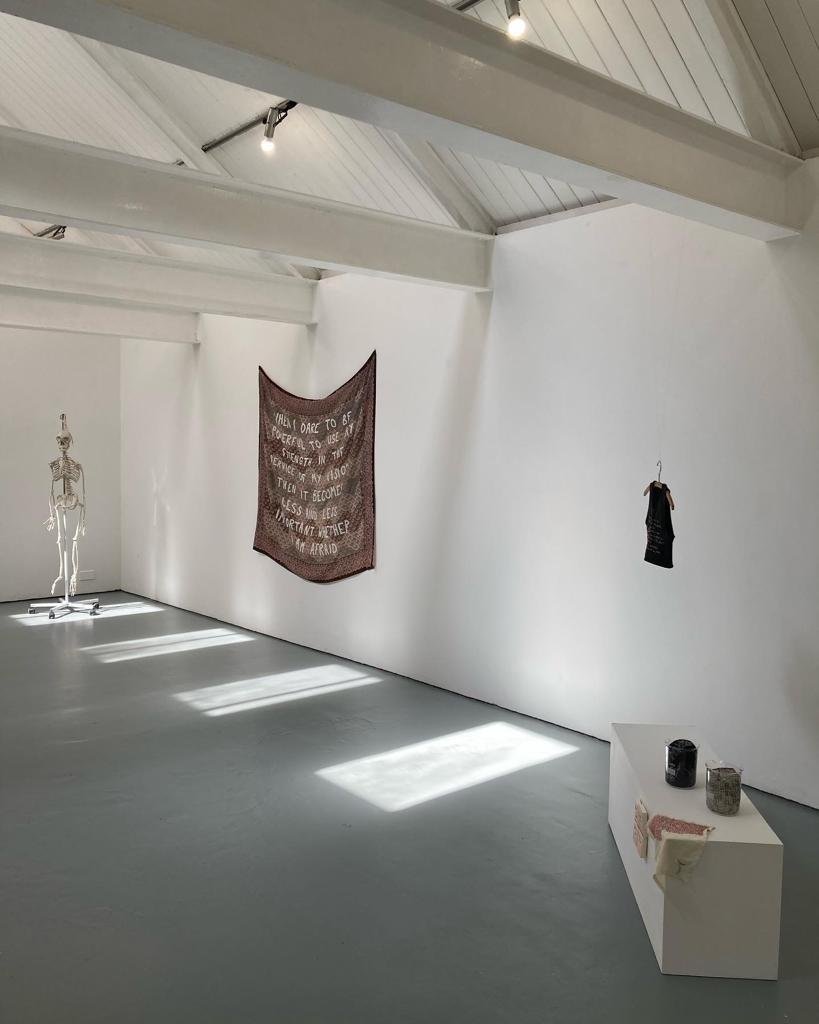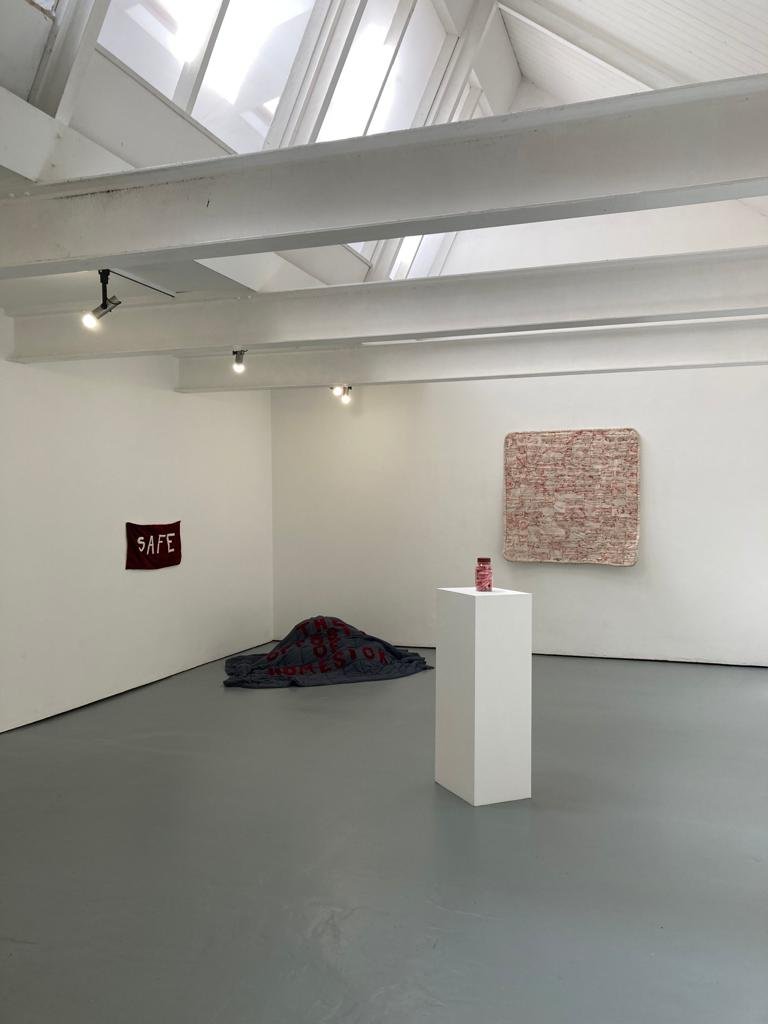#157 Hattie Porter, Alexithymia
29 April - 5 June
Thursday - Sunday, 12-6pm
Opening: 28 April, 6-9pm.
A conversation between Rosalyn McLean and Hattie Porter.
Rosalyn McLean: How are you feeling about the opening of the show?
Hattie Porter: I am excited about the show, but I also feel nervous as sharing such personal artwork feels intimate and vulnerable. I try to hold onto some of the secrets about the histories of the artworks: specific meanings they have or things that are concealed within them. It helps me to feel I can still hold onto them as mine even when sharing it with other people.
I am also very aware of the absence of the artworks which are usually displayed around my house and particularly my bedroom. I think the amount I will miss them over the next six weeks probably shows how much of myself is weaved into the threads of the artwork and how much they mean to me. There is a lot of pain in these artworks – as well as hope – and in some ways sharing that feels sad and heavy. But there is also something freeing in sharing that, and something vitally important in the way these artworks hold that pain so I don’t have to.
RM: Could you tell us a bit about your experience making Alexithymia?
HP: The artwork in this show have been made over a long period of time. The stitched blanket (untitled 2012-2022) is made from many scraps of fabric displaying the reverse side of embroidered writing. I started making parts of that when I was about 13 or 14 years old and continued as I needed to over the past decade, before I finally stitched the artwork into the form it is currently. I’ve tried to count the number of different bedrooms and homes I’ve stitched parts of this in and it must be over 10, not to mention the parks, trains, buses and waiting rooms I’ve made parts in. As a teenager I spent a few years in a psychiatric hospital and parts of this blanket were stitched with sewing needles I smuggled into the hospital and stitched in secret (as sharp objects were contraband). I think there are fragments of the many, many places I made these artworks stitched into the stories the exhibition tells.
Other artworks in this show have multiple dates, reflecting these were made at different times, shifting in form through that time. I found it interesting working with art I had made such a long time ago; I felt so disconnected from the original form that it felt like a collaboration with a younger self.
RM: As someone who hasn’t gone through the art school system, how has that impacted your process?
HP: Having never studied art beyond my textiles A-level which I studied at home or a hospital school; I find it somewhat daunting to share my art. I am very comfortable and familiar with creating art, but navigating the ‘art world’ beyond that feels entirely foreign. I have wondered if – and how – my practice would be different if I had gone to art school. It was something I considered but ultimately felt afraid of how this could change my practice and the meaning my art held for me. For me, the process of making my art has never been as much about the end result, rather the art is this exhibition is made because – without a trace of hyperbole – stitching, creating and expressing myself through art has been essential to my survival.
Instead, I study and work in healthcare which is certainly reflected in my artwork. These experiences have particularly sparked my interest in the human body, which is a theme within a lot of my artwork. I am fascinated by the anatomical and physiological functions of the body and how this interacts with the metaphorical and emotive meanings held within these structures.
RM: Some of your materials had life before you took them on as art pieces, like with the weighted blanket in ‘The opposite of homesick’ and the chest binder with ‘Bind’, can you tell us more about that?
HP: From the blankets and fabrics I use in these artworks to the thread itself, almost all of the materials I’ve used in this show are second-hand; some purchased, inherited, gifted or found. The stories held within fabric is one of the things which appeals so much to me about textiles as a medium and feels like a vital part of my artwork. For example, I used the soft blanket in ‘when I dare to be powerful’ as a quilt on my bed for some time, it was a particular favourite with the cats and gained a few extra rips from their claws!
RM: A lot of the works in Alexithymia are very text-based, how has your lived experience as a non-binary artist informed what you have to say?
HP: My identity influences all of my artwork. Although some pieces are more explicitly about identity my experiences as a queer, non-binary, autistic person influence the way I interact with the world and are therefore inherently part of the fabric of this show. It is interesting for me to see the artwork together in this show, as having been made over such a long period of time there are pieces in this show which were made before I knew I was trans, queer or autistic. I think in many ways, those older artworks speak the most of my lived experiences. I can now see so clearly what I needed to say in those artworks, I just never had the rights words at the time.
RM: Can you tell us about some of the dialogue going on between various pieces? I know that ‘Safe’ and ‘The opposite of homesick’ have a relationship between each other and I was hoping you could expand on the meaning behind that.
HP: There are different but intersecting stories told by each of the artworks here but the stories are fluid and have shifted over time. While some of the artwork expresses a deep pain, others tell the story of healing and protection from that. It felt important to place these pieces together to balance the emotions held in the work – almost as though to keep the art safe.
RM: You use a lot of different and unconventional materials in your work, is that something you’ve always experimented with?
HP: I try to let the materials themselves speak loudly in my art. I like sewing with materials that hold strong, emotional meanings to me. I want that to be embedded within every aspect of the artwork. I am interested in the way objects, particularly soft textile objects, hold meaning and history – although this can sometimes be taken for granted. I hope visitors look close enough at the artworks to notice the tiny rips in the fabrics or the small tea stains or blood stains from pricking my fingers with needles when sewing. Although I am careful when moving these artworks, they seem to pick up new marks and blemishes over time like they are alive and living their own histories.
The piece ‘the opposite of homesick’ is made from a weighted blanket which was given to me by a friend. The process of sewing this required me to curl up within the weighted blanket then physically battle with the weight of it. I hope the artwork continues to hold the enormous sense of safety and protection I found within the weight of the fabric as I stitched it.
To access the virtual exhibition click here: https://sketchfab.com/3d-models/hattie-porter-alexithymia-outpost-ee5321ed38a843b9ac762c7a375f2534
Image credit: Emma Cracknell



